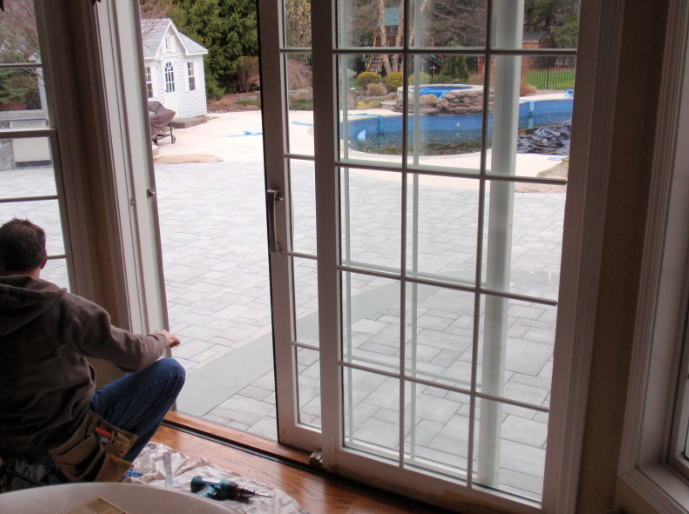
Lubricating and Cleaning Your Patio Door Track for Smooth Operation
A patio door is more than just an entrance to your backyard — it’s a gateway to outdoor relaxation, natural light, and family memories. But when that door starts to stick, grind, or skip along its track, it can quickly turn from a convenience into a frustration. Whether you’re dealing with a stiff slider or just want to keep your door gliding smoothly, a little maintenance goes a long way.
In this blog, we’ll walk you through how to lubricate and clean your patio door track to restore — or maintain — effortless operation. These steps are simple enough for DIYers of all experience levels, and best of all, they can extend the life of your Glenbrook Patio Door or any sliding door in your home.
Why Is Patio Door Track Maintenance Important?
Over time, debris, pet hair, pollen, and dust settle into your patio door track. Add in moisture or grease buildup, and it becomes the perfect recipe for friction. Left unchecked, these problems lead to:
-
Sticky or hard-to-slide doors
-
Increased wear on rollers and tracks
-
Damaged or misaligned door frames
-
Noise during operation
-
Reduced energy efficiency due to improper sealing
Routine cleaning and lubrication help prevent all these issues — keeping your Glenbrook Patio Door gliding smoothly year-round.
Tools & Supplies You’ll Need
Before we dive into the step-by-step process, make sure you have the following:
Cleaning Tools:
-
Vacuum cleaner with a hose attachment
-
Stiff-bristled brush or old toothbrush
-
Microfiber cloth or paper towels
-
Mild soap or dish detergent
-
Warm water
-
Spray bottle (optional)
Lubrication Supplies:
-
Silicone-based spray lubricant (not WD-40!)
-
Clean rag
-
Protective gloves (optional)
Pro Tip: Avoid petroleum-based lubricants like WD-40, as they can attract more dirt over time and damage plastic or rubber components.
Step-by-Step Guide to Cleaning Your Patio Door Track
Step 1: Open the Door Fully
Slide your Glenbrook Patio Door all the way open so you can access the entire length of the track. If your door is particularly dirty or stubborn, you may want to remove it temporarily (more on that later).
Step 2: Remove Loose Debris
Use a vacuum with a hose or brush attachment to remove any loose debris, dust, or pet hair from the track. Be thorough — get into the corners and crevices.
Step 3: Scrub the Track
Mix a few drops of mild dish soap in warm water. Dip your stiff brush or toothbrush into the solution and scrub the inside of the track. Focus on built-up gunk or sticky spots. You can also use a spray bottle filled with the soapy solution for easier application.
Step 4: Wipe It Down
Use a clean microfiber cloth or paper towels to wipe away the dirty water and loosened grime. Repeat this step as needed until the track is visibly clean.
Step 5: Dry the Track
Before applying lubricant, ensure the track is fully dry. Use a dry towel or let it air dry for a few minutes. This prevents moisture from diluting the lubricant or causing rust.
Step-by-Step Guide to Lubricating Your Patio Door Track
Once the track is clean and dry, it’s time to apply lubrication.
Step 1: Choose the Right Lubricant
Silicone-based lubricants are ideal for patio door tracks. They provide smooth gliding action without attracting dirt or dust. Look for products specifically labeled as safe for door tracks or sliding windows.
Avoid grease or oil-based products. These may seem to work at first, but they’ll quickly trap more grime and lead to bigger problems.
Step 2: Apply the Lubricant
Spray a thin layer of lubricant along the inside edges of the track, focusing on the area where the door rollers make contact. If your Glenbrook Patio Door has a top and bottom track, be sure to lubricate both.
Optional Tip: For extra control, spray the lubricant onto a clean cloth and then rub it along the track. This helps avoid overspray.
Step 3: Move the Door Back and Forth
Gently slide the patio door back and forth several times to work the lubricant into the rollers and track. This ensures an even distribution and reveals any remaining trouble spots.
Step 4: Wipe Away Excess
Use a clean cloth to wipe away any overspray or excess lubricant. You don’t want puddles or buildup that can attract dust or create a slipping hazard.
Optional: Remove the Door for Deep Cleaning
If your patio door is still hard to slide after cleaning and lubricating the track, the issue may lie with the rollers. In that case, removing the door and cleaning both the track and rollers is your next step.
Here’s a quick summary of how to do this:
-
Lift the door up and pull the bottom out (you may need help).
-
Lay it down gently on a soft surface like a blanket.
-
Inspect and clean the rollers using the same soap and water solution.
-
Lubricate the rollers with a silicone spray.
-
Reinstall the door by reversing the removal steps.
If the rollers are worn or damaged, consider replacing them. Glenbrook Patio Door hardware and parts are often available at local home improvement stores or directly from the manufacturer.
How Often Should You Clean and Lubricate Your Patio Door?
-
Every 3–6 months for average homes
-
Monthly if you have pets, kids, or live in a high-dust or sandy environment
-
Immediately if the door becomes hard to slide or noisy
Regular maintenance doesn’t take long and can save you hundreds of dollars in repair costs down the road.
Benefits of a Well-Maintained Patio Door
When you take a few minutes to clean and lubricate your patio door, you’re not just making it easier to open — you’re improving your entire home experience:
-
Enhanced convenience for quick outdoor access
-
Longer lifespan for door components
-
Reduced risk of damage to door frames and rollers
-
Increased home value by maintaining a functional, attractive entry
-
Improved safety with doors that close and lock properly
Whether you own a Glenbrook Patio Door or another brand, keeping it in top shape helps protect your investment and ensures your indoor-outdoor lifestyle runs smoothly.
Common Mistakes to Avoid
Even with the best intentions, some DIYers make mistakes during patio door maintenance. Here are a few to avoid:
-
Using the wrong lubricant: Stick with silicone spray; avoid oil or grease-based products.
-
Neglecting the top track: Dirt and resistance can build up there, too.
-
Forgetting to clean the rollers: If the door is still sticking after cleaning the track, check the wheels.
-
Over-lubricating: Too much lubricant can attract dirt and defeat the purpose.
When to Call a Professional
If your door remains difficult to slide after cleaning and lubricating, or if it jumps the track, doesn’t lock properly, or makes grinding noises, it may be time for professional repair or replacement. Glenbrook Patio Door experts can help diagnose issues like misaligned frames, broken rollers, or worn-out tracks.
Final Thoughts
Maintaining your patio door doesn’t have to be a chore. With just a little effort and the right products, you can keep your Glenbrook Patio Door gliding like new for years to come. Regular cleaning and lubrication not only improve daily functionality but also protect your home’s long-term value.
So the next time your patio door starts to stick, don’t reach for the sledgehammer — reach for a vacuum, some soap, and a can of silicone spray. Your patio (and your sanity) will thank you.
FAQs
1. What type of lubricant should I use on my patio door track?
Use a silicone-based spray lubricant. These are specifically designed for sliding doors and won’t attract dust or dirt like oil-based sprays.
2. Can I use WD-40 on my Glenbrook Patio Door track?
No, WD-40 is not recommended. It’s a water-displacing spray, not a long-term lubricant. It can attract dust and damage plastic parts over time.
3. How do I know if my patio door rollers need replacing?
If your door still sticks or grinds after cleaning and lubricating, or if it wobbles or falls off track, the rollers may be worn out or broken. Removing the door for inspection will confirm the issue.




